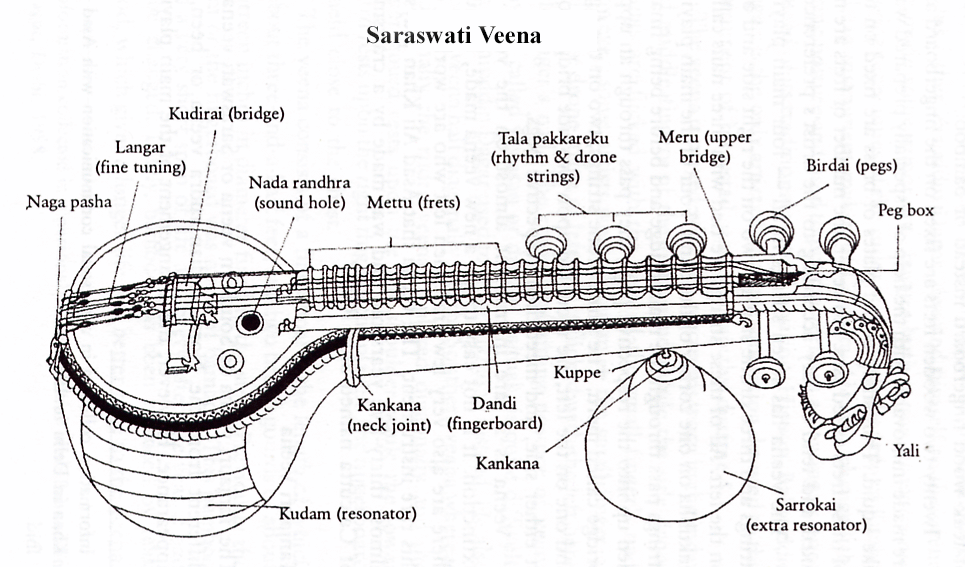Kleines Lexikon indischer Instrumente
Der Text ist in gekürzter Form von Suneera Kasliwal, Classical Musical Instruments, Delhi 2001, entnommen
Saraswati Veena
The Tanjauri veena or Southern veena or Saraswati veena is different from the North Indian rudra veena or been in appearance. However, the arrangement of the main playing and drone strings, number of frets and the method of placing them and also a number of the playing techniques remain the same. Before it acquired its present shape, the Tanjauri veena underwent different phases of modifications from the fourteenth century onwards. In fact, the kinnari veena, was changed and modified into rudra veena in the north and in the south, it was modified to acquire a new appearance as Tanjauri veena.
Contrary to the north, in the south, the veena still holds the position of queen of all musical instruments. It lends itself to all the different graces which give such beauty to Indian music. The veena has been considered the perfect instrument to demonstrate different gamakas, and thus, the veena, to some extent, influenced the style of vocal music. The south has produced a number of great vainikas for the last three centuries. Over the generations three main styles of veena playing emerged, i.e. Tanjavur style, Mysore style and Andhra style. Different postures are adopted for playing different kinds of veena, but generally two of them are common, i.e. they are vertical and horizontal.
Saraswati Veena in our catalogue
Tanjauri veena consists of a peg box, a fingerboard and a resonator. When all the three portions are scooped out of the same log of wood, it is called ekanda veena. But sometimes they are separately made and joined. The wood normally used is jack wood. The scooped wooden structure is covered with a wooden board. The resonator called kudam is deep and carved like a vessel; the hollowed fingerboard is long and curved from the bottom and ends in the peg box, which is fashioned into an animal's face, mostly of a dragon called vyali. The bridge, the most important part of the veena, is a complex unit. It stands centrally on the soundboard of the resonator. It is made of wood and is wide, slightly sloping in the direction of the strings, on the upper portion which is covered with a thin plate of brass. Four main playing strings pass through this bridge. Besides this main bridge, an additional bridge is attached to the main bridge stands. Three drone-cum-rhythm strings, called talam, pass through this side bridge. The side strings are supported by little pins before they are tied to the pegs. Four main playing strings, called sarani, pass through the fingerboard mounted on the upper bridge, called meru, before finally entering the open peg box to be tied to their respective pegs. Just before the meru where the fingerboard ends, an extra resonator either made of gourd or a thin sheet of tin, is placed. It is called surakkai. All the strings are tied to the string holder, called nagapasha, situated at the lower end of the veena and on the side of the resonator. The strings have spring-type wire knobs movable for minute adjustments called langars. On the soundboard, the covering of the resonator, two sound holes are made. These are called nadarandhra.
There are twenty-four frets which are fixed upon the fingerboard with the help of good quality beeswax and charcoal powder proportionately mixed. The best kind of frets are made out of either bronze or gunmetal, with legs to insert into the wax. Nowadays frets made of stainless steel are also in use. Strings are struck either by fingernails or by means of wire plectrums worn on the index and middle fingers of the right hand.
Nowadays fibreglass veenas are manufactured by moulding a mixture in the form of resin containing wood sap and other chemicals. The parts that are moulded and manufactured out of fibreglass are kudam, sarukai and the dragon face, the remaining parts of the veena remain the same as in the case of the wooden veena. As it is very difficult to get good quality ripe jack wood, the invention of fibreglass veena has proven to be a boon. The cost of these veenas is less, whereas the sound quality and the appearance is good. These also have the shock resistance properties and are lighter in weight than wooden veenas.
